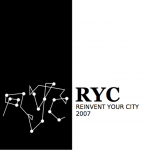雍◎和 Yong◎He
2007 基于北京雍和宫附近区域的田野录音作曲以及声音装置
* 北京千高原艺术空间《脱域》开幕展,2007
* 韩国首尔City Net Asia双年展,2007
2006年夏天,北京奥运会的前夕。北京城正在经历大规模的拆迁,翻新和建设。大概用了两个月的周末时间,从清晨到深夜,我在雍和宫,雍和宫大街,以及附近的胡同区域,持续的聆听,观察,走动,静坐,录音,攀谈,记录。我想去感受剧烈的城市变迁里,一个具体的区域中,人们具体的生活,大致是怎样的感受。
我开始把对城市声响的政治学聆听维度的关注,转移到围绕具体而微地点展开的田野工作(我称之为“城市微观声响地理”),转移到私人化的记忆,情感和感受。我试图把作曲重点,从基于日常田野录音的批判式重构,转为拓展日常声响背后更为深入的文化和心理的感受和想象空间。
田野之后,我基于自己双脚度量的附近胡同的长度和宽度,绘制了这个区域的声响地图。我又把经过挑选和剪辑的田野录音素材,借着酒意,以一种半即兴的作曲和演奏方式,直接铺成开来,做成了一首33分的长曲。它是我在北京某个夏天的一次游荡,一次梦境里的喃喃自语。它是我通过身体劳作,跟这个城市所建立的,一种难以割舍的听觉联系。
这个作品,以声音装置的方式,参加了一些展览。又在“Post-Concrete后具象”厂牌做了数字发行。十五年后的2021年,神棍唱片的“赛剋克”厂牌,做了这个作品的实体唱片出版发行。我的朋友,声音艺术家王长存,还找我聊了一期播客,交换了聆听感受,探讨了雍和的创作过程。感兴趣的,可以点击这里收听。
“Zafka十三年前的作品『雍和』2021 年由「赛剋克」出版实体 CD,不是具象音乐也不是声音电影,更像是一个由声响触发的听觉&文化的想象空间,十三年后再听这个空间甚至更深邃广阔。”—— 王长存
接下来的文字,是我当时田野工作的笔记,也是写给展览场地以及唱片出版的介绍文字。
————————————————————————————————————————————————
“雍◎和”——魔幻大街 文 / Zafka
2006年末,我从广州移居北京。我曾说,城市声响(Urban Soundscape)已经是城市正义与否的标注。我还惦记着广州的“不干净”—— 过去二十多年民间资本和移民的主导下,广州城市空间斑斓无序,声响纷繁芜杂,没有城市规划理性主义的政治洁净幻想。
相比广州,北京要“干净”得多——马路宽广笔直,全球同质的交通声响干净有力,无处不在。这个古老的都城,城市空间布局和声响环境从来都是政治秩序最现实和直接的投影。这个传统延续到现在,但政治合流资本已经是城市变迁的主导力量,加速将北京的城市发展引向“断裂”——社会整体规划与文化保存,个体物质生存发展与心理情感沉淀之间的断裂。
我挑选了雍和宫——一个我过去多年造访北京最多的区域,试图聆听并找寻这种断裂的细微之处。雍和宫位于北京二环东北角,附近有国子监,孔庙,以及众多老北京胡同。这个区域不仅是北京传统城市声响的积淀之地,所处位置更是寸土寸金。过去两年,为了迎接奥运,也为了发展经济,雍和宫附近胡同已经陆续拆迁和改建。
从听觉上来说,南北走向的雍和宫大街是这个区域的“魔幻大街”,是这个城市发展断裂的最佳注脚——选择东西双向任何一个胡同入口,往里行走10-15米,雍和宫大街嘈杂异常的交通和商业声响,转眼转换为安静平和。这是一个狭窄地理空间内剧烈转换的城市声响环境。狭窄的胡同,前工业时代城市声响的生产轴心,如今成为了对付嘈杂交通声响环境最有力的“消声器”。
同时,胡同的狭窄造就了不同于雍和宫大街的商业和社区形态,也呈现了截然不同的声响环境。胡同中最多的交通工具——自行车,三轮车,承担了大部分日常交通和商业功能(上下班,送啤酒,杂货,收破烂,送报等),构成了声响环境的主体。另外,胡同也是传统的社区空间。胡同的公共声响,部分重叠了居民的私人生活空间声响——小孩嬉闹,大人呵斥,家长里短,柴米油盐等。
但这里是资本的低地,也是城市生活的低地。我喜爱胡同的宁静,却无法假设自己也如同这胡同中的大部分群体一样生活困窘。雍和宫区域胡同里的人们,并不如人们想象那样怀旧。很多人期待离开狭窄破旧的胡同,而他们的居所,正处于政府规划地图上保护区域的标尺之内。这是一个悖论,一个孤岛,日子一天天过去,对他们来说,胡同声响的安宁已经过于廉价。而在这个城市,还有不少这样的魔幻大街。我只能多次行走在雍和宫大街和它附近的胡同,用耳机和麦克风,试图理解这段城市微观地理变迁的历史。
仍需要一些反思。已经有太多对城市断裂性变迁的批判,蜕变为不负责任的怀旧主义情调,进而演变为绝缘冷酷高高在上的道德主义。我无法埋怨在大部分人长长的城市生存需求列表上,声响环境可能只是最后一项。城市声响环境重建的未来,只有建立在城市发展本身的正义之上。这样的正义在于,在资本试图用利益最大化的逻辑横行摧毁一切时,更为深刻的政治和文化逻辑可以唤醒,可以拯救与平衡,并在让人们在自主决定自身和城市发展方向的同时,提供更为前瞻性的考量,避免发展的断裂。
事实是,一个高速变迁城市的断裂,并不只是资本和政治的简单合谋。这不是故事的全貌。每个人都是城市变化的参与者,每个人都在矛盾中度日。作为这个城市新的定居者,我所能书写的,只是一副私人城市声响地图和一张唱片,把我用脚和耳朵丈量过的地方,用一套城市微观声响地理的方法,从我的情感和体验出发,以回忆和想象——一种并不确定性的东西,把关于魔幻大街的一些,简单记载下来。我只是有些担心,那些被忘却的城市声响——不仅是物理意义上的,更是文化的,情感的,心理的,那些基于个体对自己生长的城市认知和心理的断裂,才是城市变迁断裂的最细微致命之处。我期待未来,我能听到城市声响庇护着正义,我不在乎声响是否新旧,分贝是否高低。因为那些耳朵,终究会被唤醒。
注:
● 雍
◎ 和谐。
◎ 古同“壅”,遮蔽,壅塞。
◎ 古同“拥”,拥有。
● 和
◎ 相安,谐调。
◎ 平静。
“Yong ◎ He” – The Magic Street
At the end of last year, I moved from Guangzhou to Beijing. I once said that urban soundscape is already an indicator of urban justice. I love the “uncleanness” of Guangzhou. Under the dominance of private capital and immigrants in the past two decades, the urban space of Guangzhou is colorful and disorderly, and there is no illusion of political cleanliness of urban planning rationalism.
Compared with Guangzhou, Beijing is much “cleaner”. The roads are wide and straight, and the global homogeneous traffic sounds are clean and powerful, everywhere. In this ancient capital, the urban spatial layout and acoustic environment have always been the most realistic and direct projections of political order. The tradition continues to today, but the confluence of political and capital power, has become the dominant force in urban change, accelerating Beijing’s urban development to “fracture”-the rift between overall social planning and cultural preservation, individual material survival and development, and psychological and emotional precipitation .
I chose the Lama Temple, an area I have visited the most in Beijing in the past years, trying to listen to and find the subtleties of this fracture. The Lama Temple is located at the northeast corner of Beijing’s Second Ring Road, near the Imperial Palace, the Temple of Confucius, and many old Beijing hutongs. This area is not only a place where Beijing’s traditional sound accumulates, but also its location is an inch of gold. In the past two years, in order to welcome the Olympics and develop the economy, the hutongs near the Lama Temple have been demolished and rebuilt one after another.
From the auditory point of view, Lama Temple Street, which runs from north to south, is the “magic Street” of this area, and is the best footnote to the development of this city. Choosing any hutong entrance from east to west, walking 10-15 meters inward, Lama Temple Street’s noisy traffic and business sounds turned into quietness and peace in a blink of an eye. This is an urban acoustic environment that changes drastically in a narrow geographic space. The narrow alleys, the production axis of urban sound in the pre-industrial era, have now become the most powerful “mufflers” for dealing with the noisy traffic environment.
At the same time, the narrowness of Hutong creates a business and community form different from Lama Temple Street, and also presents a completely different acoustic environment. Bicycles and tricycles, the most common means of transportation in the Hutong, undertake most of the daily transportation and commercial functions (coming to and from get off work, delivering beer, groceries, collecting tatters, delivering newspapers, etc.) and constitute the main body of the acoustic environment. In addition, Hutong is also a traditional community space. The public sound of the hutong partly overlaps the sound of the private living space of the residents—children frolicking, adults scolding, kitchen cooking and etc.
But here is the lowland of capital and the lowland of urban life. I love the tranquility of the hutong, but I can’t assume that I live in the same embarrassment as most groups in this hutong. The people in the hutongs of the Lama Temple area are not as nostalgic as people think. Many people look forward to leaving the narrow and run-down hutongs, and their residences are within the scale of the protected area on the government planning map. This is a paradox, an isolated island, day by day, for them, the tranquility of the alley sounds is too cheap. And in this city, there are many such magical streets. I can only walk many times in Lama Temple and the hutongs near it, using headphones and microphones to try to understand the history of this city’s micro-geographical changes.
There have been too many criticisms of the fractured changes in the city, which has degenerated into an irresponsible nostalgic mood, and then evolved into an insulating, cold and high moralism. I can‘t complain that on the long list of most people’s urban survival needs, the sound environment may only be the last item. The future of urban sound environment reconstruction can only be based on the justice of urban development itself. Such justice lies in the fact that when capital is trying to destroy everything with the logic of maximizing benefits, a deeper political and cultural logic can be awakened, rescued and balanced, and while allowing people to independently determine the direction of development of themselves and the city, provide more forward-looking considerations to avoid development breaks.
The fact is that the rupture of a rapidly changing city is not just a simple conspiracy of capital and politics. This is not the whole story. Everyone is a participant in the change of the city, and everyone is living amidst contradictions. As a new settler in this city, all I can write is a private city sound map and a record about the Lama Temple area. I am just a little worried. Those forgotten city sounds, not only in the physical sense, but also cultural, emotional, and psychological, are the most subtle and fatal parts of urban changes. I look forward to the future, I can hear the sound of the city sheltering justice, I don’t care whether the sound is new or old, whether the decibel is high or low. Because of those ears, they will eventually be awakened.

























